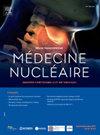Prise en charge de la maladie de Basedow dans l’Ouest algérien
IF 0.2
4区 医学
Q4 PATHOLOGY
Medecine Nucleaire-Imagerie Fonctionnelle et Metabolique
Pub Date : 2025-06-03
DOI:10.1016/j.mednuc.2025.04.002
引用次数: 0
Abstract
Hyperthyroidism is a pathological condition marked by an excess of thyroid hormones in the bloodstream. The most common observed etiology is Graves’ disease. In order to establish the epidemiological profile of this disease in the Algerian west and evaluate its treatment in nuclear medicine, we conducted a retrospective, cross-sectional study from January 2014 to December 2023 at the University Hospital Establishment of Oran, including 180 folders of patients suffering from hyperthyroidism. We report a high prevalence of Graves’ disease (98.33%) with a notable female predominance of 72.88%. A peak incidence is noted across all genders between the ages of 31 and 50. In Algeria, radiotherapy with iodine 131 is generally indicated as a second line after antithyroid drugs treatment. In our study, one hundred and sixty-five patients have received radioactive activities administered empirically (extremes: 8–28 mCi). An activity below 15 mCi was administered to 67.27% of patients, between 15 mCi and 20 mCi to 30.3% of patients, and only 2.42% received an activity exceeding 20 mCi. A single dose was administered in 98.18% of cases, while only three patients (1.82%) received a second. Finally, the RAI therapy was successful in 85.83% of cases over a follow-up period ranged between 1 and 9 months. These observed results are promising and encourage healthcare professionals to consider the radiotherapy as an early treatment of Graves’ disease.
控制阿尔及利亚西部的巴塞多病
甲状腺机能亢进是一种以血液中甲状腺激素过多为特征的病理状态。最常见的病因是格雷夫斯病。为了建立该疾病在阿尔及利亚西部的流行病学概况并评估其在核医学中的治疗,我们于2014年1月至2023年12月在奥兰大学医院进行了回顾性横断面研究,包括180例甲状腺功能亢进患者。我们报告了Graves病的高患病率(98.33%),其中女性患病率为72.88%。在31岁至50岁之间的所有性别中发病率最高。在阿尔及利亚,碘131放射治疗通常作为抗甲状腺药物治疗后的二线治疗。在我们的研究中,165名患者接受了经验性放射性活动管理(极值:8-28 mCi)。67.27%的患者活动低于15 mCi, 30.3%的患者活动介于15 mCi和20 mCi之间,只有2.42%的患者活动超过20 mCi。98.18%的病例接受了单剂治疗,而只有3例患者(1.82%)接受了第二次治疗。最后,在1至9个月的随访期间,RAI治疗的成功率为85.83%。这些观察到的结果是有希望的,并鼓励医疗保健专业人员考虑放射治疗作为格雷夫斯病的早期治疗。
本文章由计算机程序翻译,如有差异,请以英文原文为准。
求助全文
约1分钟内获得全文
求助全文
来源期刊
CiteScore
0.30
自引率
0.00%
发文量
160
审稿时长
19.8 weeks
期刊介绍:
Le but de Médecine nucléaire - Imagerie fonctionnelle et métabolique est de fournir une plate-forme d''échange d''informations cliniques et scientifiques pour la communauté francophone de médecine nucléaire, et de constituer une expérience pédagogique de la rédaction médicale en conformité avec les normes internationales.

 求助内容:
求助内容: 应助结果提醒方式:
应助结果提醒方式:


